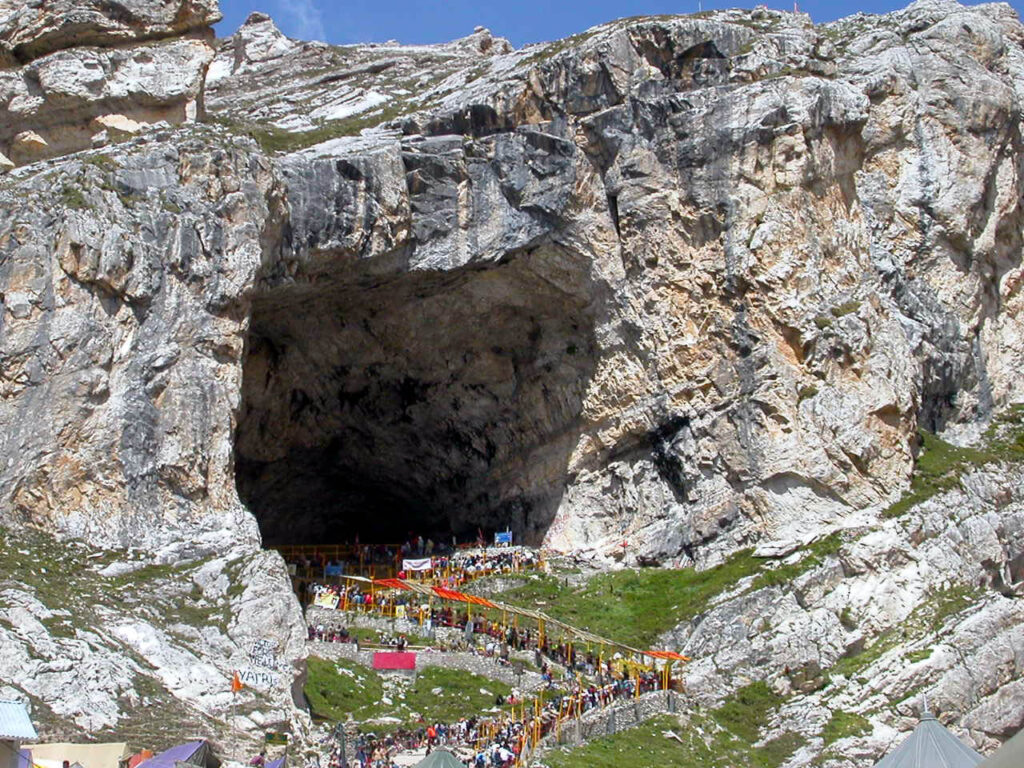
Nestled amidst the breathtaking peaks of the Kashmir Himalayas lies the holy cave shrine of Amarnath. Every year, during the summer months, thousands of devotees embark on a challenging yet spiritually rewarding pilgrimage to venerate the revered ice lingam (natural ice formation) enshrined within the cave. The smooth functioning and responsible management of this sacred pilgrimage falls under the purview of the Shri Amarnathji Shrine Board (SASB).
Origins and Mandate
Established in the year 2000 by an Act of the Jammu and Kashmir State Legislature, the Shri Amarnathji Shrine Board serves as the sole governing body for the Shri Amarnathji Yatra (pilgrimage). Headed by the Honorable Lieutenant Governor of the Union Territory of Jammu and Kashmir, the Board comprises a Chief Executive Officer, a senior IAS officer, and eight distinguished members.
The core mandate of the SASB revolves around ensuring the well-being of pilgrims undertaking the Yatra. This encompasses a wide range of responsibilities, including:
- Registration and Permit Issuance: The SASB streamlines the registration process for pilgrims, facilitating a smooth and secure journey. Through a designated online portal and designated bank branches, aspiring Yatris (pilgrims) can register and obtain the mandatory Yatra permits.
- Infrastructure Development and Yatra Route Management: The challenging terrain necessitates robust infrastructure for a safe pilgrimage. The SASB spearheads the development and maintenance of Yatra routes, including the establishment of temporary shelters, medical camps, sanitation facilities, and communication networks along the designated paths.
- Security and Crowd Management: The Yatra attracts a large influx of devotees, necessitating robust security measures. The SASB collaborates with various security agencies to ensure the safety of pilgrims throughout the pilgrimage. Crowd management strategies are also implemented to streamline movement and prevent congestion on the routes.
- Environmental Protection: The fragile Himalayan ecosystem requires responsible conduct from pilgrims. The SASB enforces strict environmental regulations, promoting eco-friendly practices and waste management initiatives during the Yatra.
- Medical Services and Emergency Response: The high altitude and challenging journey can pose health risks to pilgrims. The SASB establishes a comprehensive network of medical camps along the Yatra routes, staffed by qualified doctors and medical personnel. An emergency response system is also in place to address any medical exigencies faced by pilgrims.
- Dissemination of Information: For informed decision-making, the SASB actively disseminates crucial information pertaining to the Yatra. This includes registration procedures, health advisories, weather updates, Yatra route details, and essential dos and don’ts for pilgrims. The SASB website and designated helplines serve as key channels for information dissemination.
Challenges and Endeavors
The Shri Amarnathji Yatra presents a unique set of logistical and administrative challenges. The high-altitude terrain, coupled with unpredictable weather conditions, necessitates meticulous planning and execution. The SASB constantly strives to improve the Yatra experience by:
- Upgrading Infrastructure: The Board continuously invests in infrastructure development to enhance comfort and safety for pilgrims. This includes the construction of permanent shelters, improvement of sanitation facilities, and upgradation of medical camps along the Yatra routes.
- Technological Advancements: The SASB embraces technology to streamline the Yatra experience. Online registration portals, mobile applications with real-time information, and cashless transaction options contribute to a more convenient pilgrimage process.
- Sustainability Initiatives: Minimizing the environmental impact of the Yatra is a top priority for the SASB. Promoting eco-friendly practices, such as the use of biodegradable materials and waste management strategies, helps to conserve the pristine Himalayan environment.
- Promoting Inclusivity: The SASB recognizes the importance of inclusivity and accessibility. Efforts are being made to make the Yatra experience more accessible for physically challenged pilgrims and senior citizens.

Beyond the Yatra
The Shri Amarnathji Shrine Board‘s responsibility extends beyond the Yatra period. Throughout the year, the Board undertakes various activities related to the shrine’s upkeep and preservation. This includes:
- Shrine Management: The Board oversees the year-round upkeep and maintenance of the holy cave shrine.
- Religious Observances: The SASB facilitates the conduct of daily prayers and rituals at the shrine.
- Social Responsibility: The Board actively contributes to the socio-economic development of the surrounding communities. This includes initiatives promoting education, healthcare, and livelihood opportunities.
The Significance of the Shri Amarnathji Shrine Board
The Shri Amarnathji Shrine Board plays a pivotal role in ensuring the sanctity and smooth conduct of the Shri Amarnathji Yatra. Through meticulous planning, infrastructure development, and a commitment to sustainability, the SASB facilitates a safe and spiritually enriching pilgrimage experience for countless devotees.
Interfaith Harmony
The Shri Amarnathji Yatra transcends religious boundaries and embodies the spirit of interfaith harmony. The cave shrine is revered by Hindus, Muslims, and Sikhs alike, with many local Muslims actively participating in the Yatra by providing logistical support and essential services to pilgrims. The SASB fosters this spirit of inclusivity and mutual respect, ensuring a peaceful and harmonious pilgrimage experience for all.
Socio-Economic Impact
The annual Yatra significantly impacts the socio-economic fabric of the surrounding region. The influx of pilgrims creates temporary employment opportunities in various sectors, such as transportation, hospitality, and retail. The SASB recognizes this impact and strives to create a sustainable economic ecosystem that benefits local communities.
Looking Ahead
As the popularity of the Shri Amarnathji Yatra continues to grow, the SASB faces the challenge of accommodating the increasing number of pilgrims while preserving the sanctity of the pilgrimage and the fragile Himalayan ecosystem. The Board’s future endeavors will likely focus on:
- Capacity Building: Developing permanent infrastructure, such as additional shelters and improved sanitation facilities, to accommodate larger numbers of pilgrims without compromising their safety and comfort.
- Sustainable Practices: Implementing stricter environmental regulations, promoting eco-friendly initiatives, and encouraging responsible behavior among pilgrims to minimize the Yatra’s environmental footprint.
- Technological Advancements: Leveraging technology to enhance communication, information dissemination, and crowd management during the Yatra.
- Community Engagement: Fostering closer collaboration with local communities for their continued support in managing the Yatra and ensuring the well-being of pilgrims.
Conclusion
The Shri Amarnathji Shrine Board stands as a testament to the collective effort required to ensure the smooth conduct of a sacred pilgrimage. Through meticulous planning, unwavering dedication, and a commitment to sustainability, the SASB continues to bridge the gap between faith and practicality, facilitating a spiritually enriching journey for countless devotees year after year. The Board’s ongoing endeavors not only ensure the well-being of pilgrims but also contribute to the cultural heritage, interfaith harmony, and socio-economic development of the region.
FAQs on the Shri Amarnathji Shrine Board (SASB)
1. What is the Shri Amarnathji Shrine Board?
Ans. The SASB is a government body responsible for managing the annual Shri Amarnathji Yatra, a Hindu pilgrimage to the Amarnath cave shrine in Jammu and Kashmir.
2. What are the main responsibilities of the SASB?
Ans. The SASB handles Yatra registration, infrastructure development, medical services, security, environmental protection, and information dissemination for pilgrims.
3. How do I register for the Amarnath Yatra?
Ans. Registration for the Yatra is done online through the SASB website or at designated bank branches. You’ll need a valid ID, medical certificate, and to pay a registration fee.
4. What kind of infrastructure does the SASB manage?
Ans. The SASB oversees temporary shelters, medical camps, sanitation facilities, communication networks, and maintains the Yatra routes.
5. What are some of the environmental initiatives by the SASB?
Ans. The SASB promotes eco-friendly practices like using biodegradable materials and implementing waste management strategies during the Yatra.
6. Does the SASB offer any medical assistance during the Yatra?
Ans. Yes, the SASB establishes medical camps staffed by doctors along the Yatra routes to address pilgrims’ health needs.
7. How can I find information about the Yatra?
Ans. The SASB website and designated helplines provide crucial information regarding registration, health advisories, weather updates, Yatra routes, and essential dos and don’ts.
8. Does the SASB play any role beyond the Yatra period?
Ans. Yes, the SASB manages the year-round upkeep of the shrine, facilitates religious observances, and contributes to the socio-economic development of nearby communities.
9. Is the Amarnath Yatra open to all religions?
Ans. While the shrine is revered by Hindus, the Yatra itself embodies interfaith harmony. Muslims and Sikhs often participate by providing logistical support and essential services.
10. What are some future challenges for the SASB?
Ans. Accommodating increasing pilgrims, preserving the environment, and leveraging technology for better Yatra management are key future challenges.


